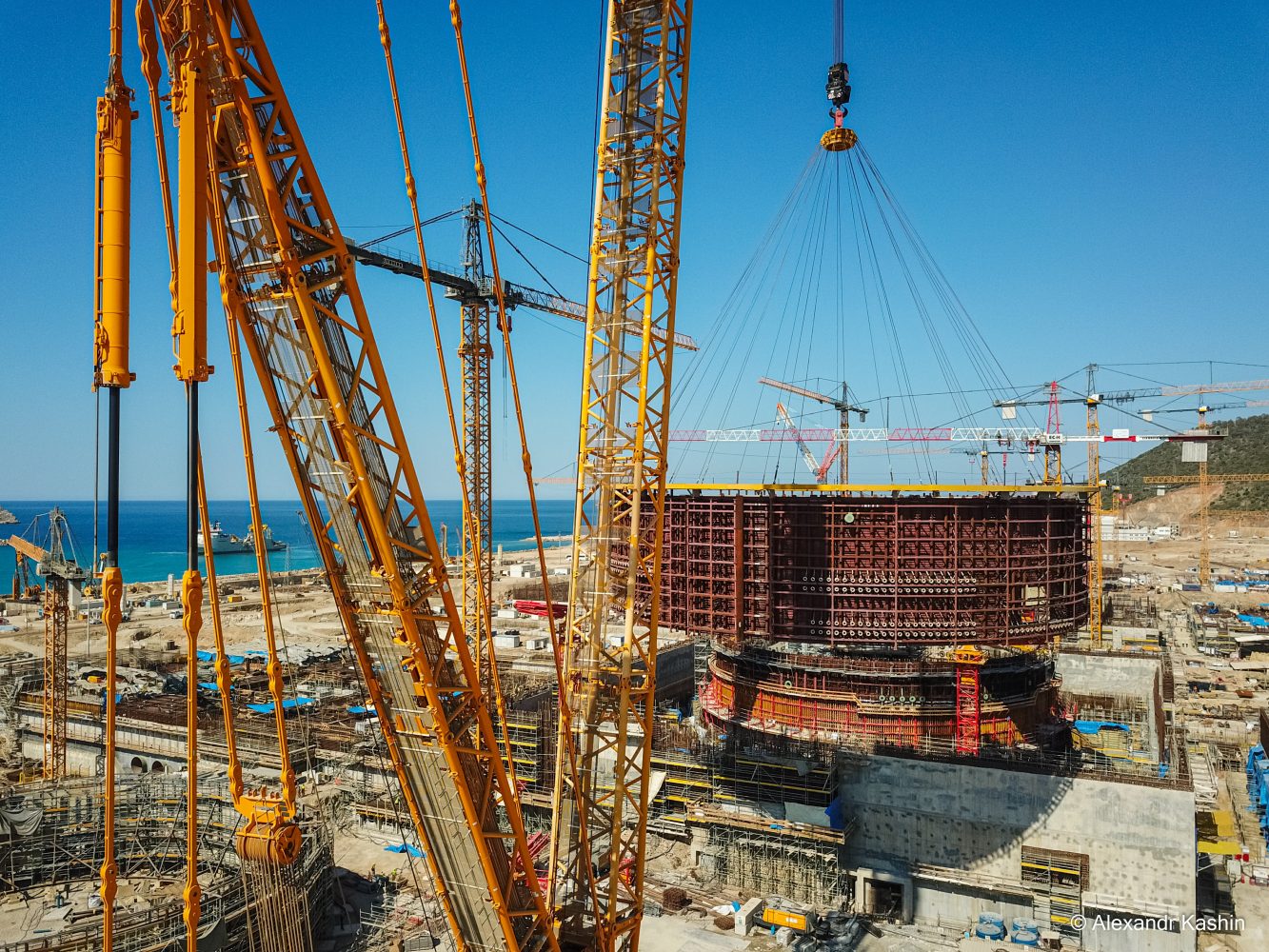
Atom Stimulates Turkish Economy
back to contentsThe installation of the reactor pressure vessel for Unit 1, one of the milestones of the equipment assembly process, was completed at the Akkuyu nuclear power plant.
The operation required on-site roads to be prepared specifically for transportation of the heavy RPV to the construction ground of Unit 1. After the roads were reinforced and leveled, a special wheeled platform delivered the RPV from the temporary storage site to the construction ground. Then the RPV was put in a vertical position with a crawler crane, lifted above the reactor island and lowered into the reactor pit.
Weighing 330 tons, the RPV measures 4.5 meters in diameter and 12 meters high.
 “The installation of the reactor pressure vessel at Unit 1 is one of this year’s main events. I would like to note the impeccable work of the installation team and the operators of the lifting equipment. The installation of the vessel must be performed with pinpoint accuracy: the maximum permissible horizontal deviation does not exceed a tenth of a millimeter. Completing the RPV installation will allow us to continue work on the reactor shaft construction,” said Sergei Butskikh, First Deputy CEO at AKKUYU NUCLEAR and director of the under-construction nuclear power plant.
“The installation of the reactor pressure vessel at Unit 1 is one of this year’s main events. I would like to note the impeccable work of the installation team and the operators of the lifting equipment. The installation of the vessel must be performed with pinpoint accuracy: the maximum permissible horizontal deviation does not exceed a tenth of a millimeter. Completing the RPV installation will allow us to continue work on the reactor shaft construction,” said Sergei Butskikh, First Deputy CEO at AKKUYU NUCLEAR and director of the under-construction nuclear power plant.
The installation process was supervised by representatives of the Nuclear Regulatory Authority (NDK), French engineering group Assystem acting as an independent construction auditor, and Rosatom companies.
The RPV was installed using the Open Top technology, through the uncovered top of the cylindrical part of the reactor building. The technology combines construction and installation operations in the best way possible and thus allows starting the equipment installation and piping assembly before the completion of the floor concreting. The technology has proven itself in many NPP construction projects in China, Japan, Bulgaria and Russia, including the construction of VVER‑1200 power units at Leningrad NPP II. The Open Top technology will be used to install steam generators, pressure compensators, main circulation pumps and other core reactor equipment inside the Akkuyu NPP reactor buildings.
As soon as the RPV is in place, construction workers will proceed with concreting the reactor pit, install bearings for the main circulation pipeline (MCP) components and steam generators. After the installation of steam generators and casings of the reactor coolant pumps, it will be possible to start welding the MCP, which connects the core equipment of the plant’s primary loop.
The RPV for Unit 1 was delivered to the Akkuyu NPP construction site by sea in November 2020. After being unloaded at the Eastern Cargo Terminal, the RPV was transported to the storage site, where it passed the incoming inspection procedure that confirmed its integrity and high quality of manufacturing.
In early June, Tier 3 of the internal containment shell was installed at the Akkuyu NPP Unit 1 reactor building. The installation of a cylindrical structure weighing 322 tons took about a day.
With Tier 3 installed, the reactor building grew 11.6 meters to reach +28.55 meters. The next step will be to join the second and third tiers, reinforce and concrete the shell. The walls will be 1.2 meters thick. In total, the internal containment shell will consist of four tiers and a dome. As soon as all the components are installed, the shell will be tested for tightness.
The 3rd tier of the internal containment has been installed at Akkuyu NPP Unit 1 in Turkey. It is a welded metal structure consisting of 24 sections, each 11.5 m high, 5.8 m wide and weighing 13.4 tons. The installation took a whole day and we can spend a day watching this video pic.twitter.com/wmTHP8qfJC
— Rosatom Global (@RosatomGlobal) June 22, 2021
The third tier of the internal containment shell is a welded metal structure consisting of 24 sections, each 11.5 m high, 5.8 m wide and weighing 13.4 tons. The sections were pre-assembled into a single block with a circumference of 138 meters on a special ground near the Unit 1 reactor building. After the structure was assembled, the quality of all welded joints was confirmed by ultrasonic testing.
Today, we want to celebrate a huge milestone for clean energy in Turkey. Feast your eyes on this gorgeous video covering Akkuyu NPP Unit 1 reactor pressure vessel installation. A warm summer day, seaside, green energy – what's not to like, eh? pic.twitter.com/4Qjt9NkU9N
— Rosatom Global (@RosatomGlobal) June 2, 2021
Before that, Unit 1 had a core catcher assembled, two structural supports concreted, and a dry shield and thermal insulation of the vessel’s cylindrical part installed. Right before the RPV installation, a support ring, which bears the entire load of the vessel, was fixed inside the reactor pit.
The Akkuyu project makes a solid contribution to the development of Turkey’s national economy. Said Anton Dedusenko, Chairman of the Board at AKKUYU NUCLEAR, in his speech at the opening ceremony of NPPES 2021. He reminded that the International Energy Agency had designed a global sustainable recovery plan for the energy sector in 2020. Its three main goals are to maintain and create jobs, boost economic growth, and improve energy sustainability and resilience. He added that new nuclear projects across the globe met the three goals.
Anton Dedusenko noted that Akkuyu would generate nearly 35 billion kWh of electricity per annum after commissioning. “This means the plant will meet 10 % of the country’s demand for electric power. It is safe to say the construction project has turned into a point of attraction for people. It is a project that improves local production, creates new jobs, and offers many business opportunities to international companies,” he said. Anton Dedusenko also stressed that local content in the Turkish project accounted for about 40 % of works and supplies at the current construction phase with over 400 Turkish companies included in the authorized supplier list.
Experts point out the role of Akkuyu in the economic growth and creation of new jobs. According to Dr. Rahmi İncekara, Assistant Professor of the International Trade and Logistics Department of Istanbul Kent University, the cost of construction of a single power unit is equivalent to three months’ costs of imported natural gas. “Every month the Turkish economy will receive around USD 7.2 billion, plus we will not spend money to buy electricity from abroad. If we consider those two factors, diversification of energy sources and independence from external supplies, the nuclear project is extremely beneficial,” he added.
Since the work on the construction site was not suspended during the pandemic, the Akkuyu NPP became one of major employers in the country. At present, nearly 11,000 people are involved in the project. It is expected that their number will grow to 12,500 at the peak of the construction, but decrease to 4,000 after the plant is commissioned. What makes Akkuyu special is the level of female employment as more than 1,000 women work at the construction site.
Alikaan Ciftci, Chairman of the Nuclear Industry Association (NSD), points out, “According to a study by the Nuclear Energy Institute based in Washington, every 100 employees of nuclear power plants create about 66 more jobs in other areas. So, in addition to direct employment at nuclear plants, it is important to remember about indirect employment. If we count jobs in Turkish companies supplying goods and services for nuclear power plants, we will arrive at very large figures. What is more, our economy will have much more added value as the use of nuclear technology expands.”
The Akkuyu NPP project will be a driver of education, Prof. Dr. Niyazi Meriç from Ankara University Institute of Nuclear Sciences, is sure, “For now, Turkey has only three departments offering nuclear-related majors. I am sure there will be more institutes to train researchers willing to work in this area after the Akkuyu NPP is commissioned. Nuclear technology has penetrated in almost every area of life even if we have no clue. I believe that the nuclear plant construction will stimulate Turkish students to seek degrees in nuclear energy.”
Nuclear Power Plants Expo & Summit (NPPES)
The 4th summit and the 8th exhibition dedicated to nuclear energy was held online this year. The agenda of the event included discussions of nuclear technology in Turkey and business opportunities for Turkish companies in connection with the Akkuyu Project.
NPPES was organized by the Ministry of Energy and National Resources of Turkey, Scientific and Technological Research Council of Turkey (TÜBİTAK), Nuclear Industry Association of Turkey (NSD), and Ankara Chamber of Industry. Key partners of the NPP Expo and Summit are Rosatom and AKKUYU NUCLEAR.
AKKUYU NUCLEAR was established in Ankara in December 2010. The Akkuyu nuclear power plant is constructed on Turkey’s southern coast in the Mersin Province. The plant will have four power units with VVER‑1200 reactors and a total capacity of 4,800 MW. The project is governed by the Russian-Turkish Agreement on Cooperation in Akkuyu NPP Construction and Operation.




